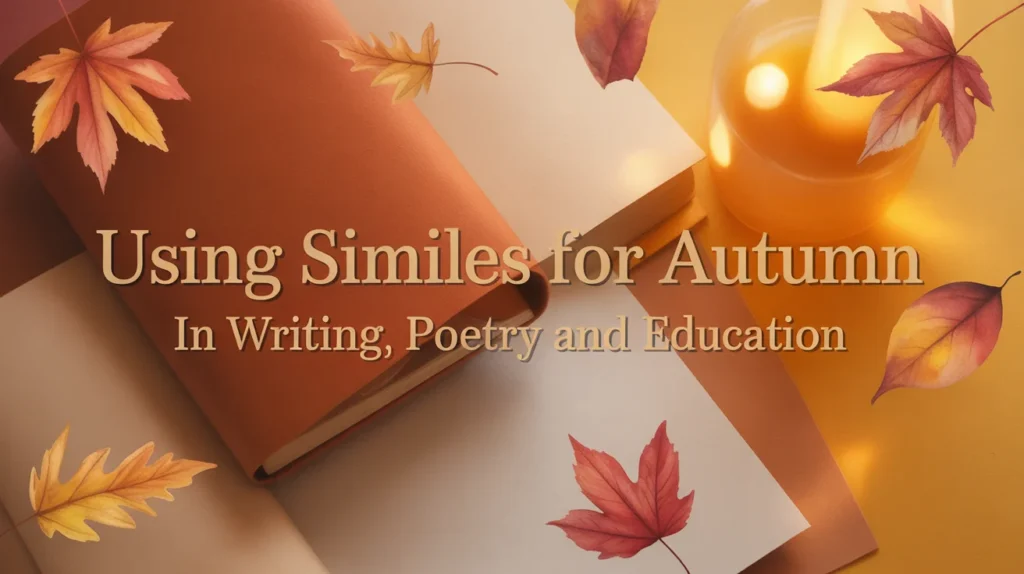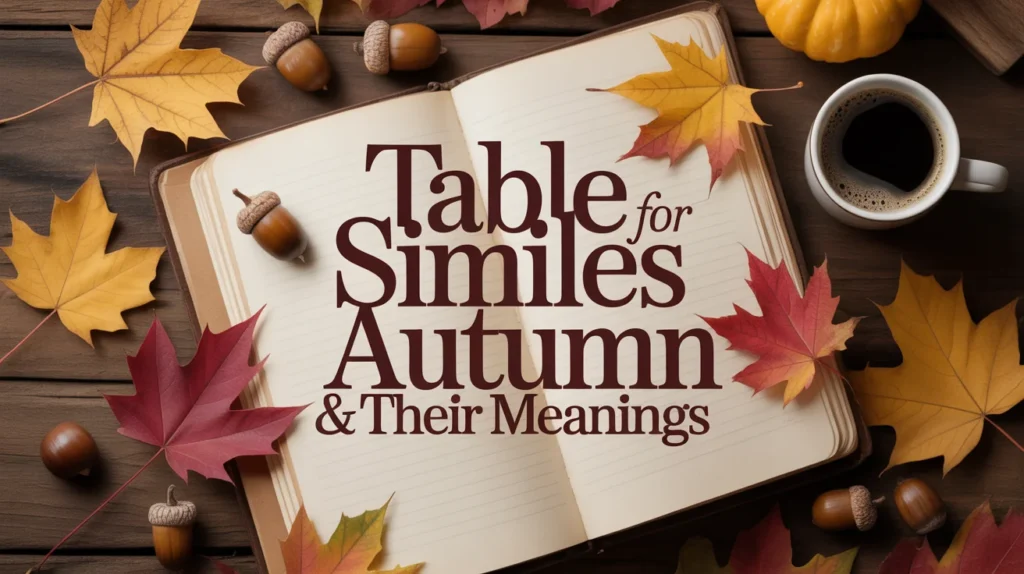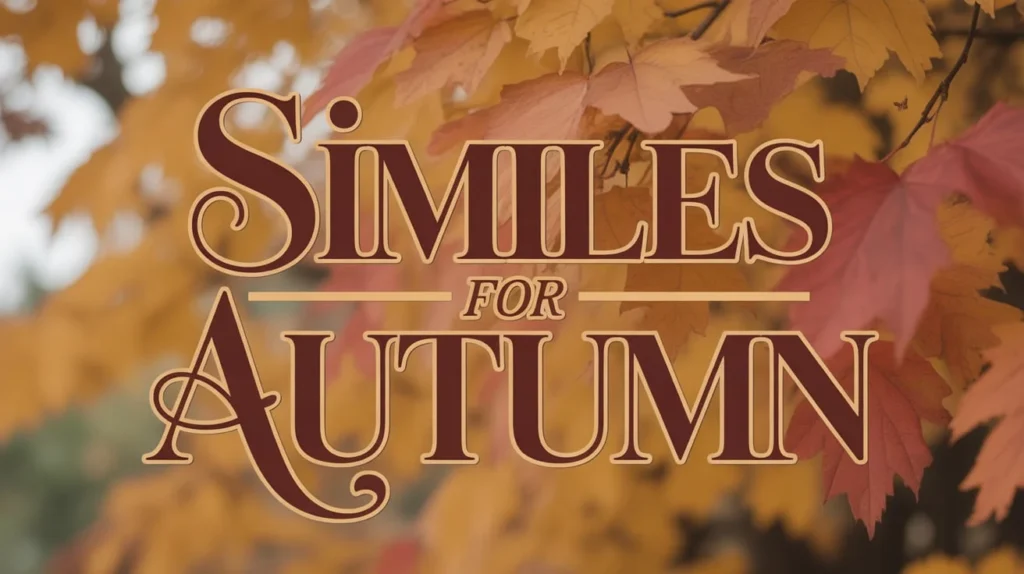Autumn is more than just a transition between summer and winter—it is a poetic canvas of swirling leaves, crisp air, and quiet reflection. When we search for the right words to capture this season’s essence, similes for autumn become our brush strokes: vivid, evocative, and deeply rooted in emotion.
In this article, we’ll explore why similes enrich our understanding of autumn, how to craft them effectively, and offer a rich collection of fresh similes and uses you can embed in your writing or speaking.
What is a Simile — and Why Use It in Describing Autumn?
A simile is a figure of speech that makes a direct comparison between two things using the words like or as. Wikipedia+1 When you say “the leaves were as golden as fields of wheat under the autumn sun”, you’re invoking an image that helps a reader feel, see, and even smell the moment.
Why similes work so well for autumn:
- Autumn is rich in sensory detail (color, sound, smell, temperature) and similes allow us to convey that richness.
- The changes of the season (green to gold, warmth to chill, fullness to decline) naturally invite comparison.
- Similes give familiar experiences a fresh twist—helping your reader connect emotionally.
- They elevate writing from plain description to memorable imagery.
By using similes for autumn, you not only describe what happens but also what it feels like. And for writers, poets, educators, or anyone reflecting on the season, that matters.
How to Craft Great Similes for Autumn

Before diving into dozens of example similes, let’s look at techniques to create your own—and ways to make them feel polished and original.
1. Focus on the senses
Autumn isn’t just visual; it’s tactile, auditory, aromatic. Consider crisp leaves underfoot, the hush of the woods, the smell of wood smoke. Using sensory detail makes your similes richer. Obsessed With Learning
2. Use ‘like’ or ‘as’ but avoid clichés
While “as red as a maple leaf” works, pushing for fresh comparisons adds sparkle: “leaves like embers drifting across the sky” rather than the over-used pumpkin references.
3. Combine familiar objects with unexpected ones
Link autumn to something widely understood but slightly surprising. For instance: “Autumn blew in like a librarian shushing summer’s laughter.”
4. Keep context in mind
A simile must feel appropriate to the mood. If the tone is serene: “the morning air was as still as a slumbering orchard”. If it’s melancholy: “autumn came like an overdue farewell, soft and deliberate.”
5. Use table/plot to practice
StepWhat to Ask YourselfExample OutcomeSenseWhat do I see/hear/feel/smell?Leaves rustling, air chilledTargetWhat familiar thing can I compare this to?A quilt, a sigh, a flameSimileForm the comparison“Leaves fall like silent longings”
By practising these steps, you’ll build a toolbox of fresh, evocative similes for autumn.
A Rich Collection of Similes for Autumn
Below is a categorized list of similes you can use as inspiration, adapt, or insert directly into your writing. Each category captures a facet of autumn’s character.
🍂 Visual and Colour Similes
- “The trees blazed like a bonfire in twilight.”
- “The horizon glowed as golden as harvest wheat under the autumn sun.” simileking.com+1
- “Leaves fluttered like red and orange confetti across the boulevard.” allsimiles.com+1
- “The forest looked like a patchwork quilt stitched with autumn hues.” simileking.com
- “The sky above was as clear as a frost-kissed windowpane.”
🍃 Atmosphere, Mood & Sound Similes
- “The wind whispered like old memories shedding their leaves.”
- “The air felt as crisp as a freshly bitten apple.” teachervision.com+1
- “The forest stood as quiet as an abandoned chapel in twilight.” allsimiles.com
- “Autumn arrived like a hushed audience taking its seats for winter’s act.”
- “The rain tapped as softly as fingers idly tracing leaf veins.”
🍁 Transition, Change & Reflection Similes
- “Autumn slipped in like a silent visitor, rearranging the furniture of the world.”
- “The season turned as slowly as pages in a well-loved book nearing its end.”
- “The leaves drifted as quickly as the hours of a golden afternoon.” simileking.com
- “The day ended like the final chord of a symphony—warm, resonant, then gone.”
- “Nature exhaled like a burden lifted, and autumn spread in the wake.”
🍎 Comfort, Harvest, Warmth Similes
- “The orchard glowed like candle-lit windows in a cold evening.”
- “The scent of cider rose as rich as velvet drapes in a harvest hall.” simileking.com+1
- “Pumpkins sat like sentinels guarding the season’s gate.”
- “A scarf wrapped around the neck felt like autumn’s gentle embrace.”
- “The pie was as comforting as a grandmother’s lullaby on a gusty evening.”
🌬 Ephemeral Beauty & Melancholy Similes
- “Joy flickered like candle-light through swaying branches before the dusk.”
- “The moment was as fleeting as a falling leaf drifting into memory.” simileking.com+1
- “The sunshine lay on the ground like a memory of summer, fading already.”
- “The world turned as quiet as the pause between heartbeats.”
- “Autumn stood like a farewell, gentle but inevitable.”
Using Similes for Autumn in Writing, Poetry and Education

Applications in Creative Writing
- Use a simile at the start of a scene to ‘set the season’ immediately: “The morning was as chill as the unspoken words between them.”
- Mix similes and metaphors (but avoid overloading): “The leaves danced like flame, and the fields lay like amber seas.”
- Use similes in dialogue or reflections for emotional depth: “Walking through this grove feels like stepping into a memory I never made.”
For Poetry and Prose
- In poems: a well-placed simile becomes the anchor image: “Autumn drifts like a daydream softening busy days.” allsimiles.com
- In descriptive paragraphs: combine several similes to layer description, then let show-rather-than-tell take over.
For Teaching & Classroom Use
- Ask students: “Write three similes for autumn using the five senses.” (See teaching resources on the topic.) teachervision.com+1
- Use a table for brainstorming:
SenseAutumn FeatureSimile ExampleSightgolden leaves“like coins scattered on a green carpet”Soundrustling leaves“as crisp as bones cracking at midnight” (playful)Smellwood smoke“as rich as tales told by an old fire-side”Touchchill breeze“as sharp as the edge of a memory”Tasteapple cider“as sweet as shawls knitted for small hands”
Internal Linking Suggestions (for blog posts)
- Link to a piece on “Figurative Language in Autumn Writing”
- Link to “Metaphors for Autumn” as a companion piece
- Link to “Writing Descriptive Essays: Autumn Edition”
Table Sample Similes for Autumn & Their Meanings

SimileMeaningRecommended Use“The leaves were as golden as fields of wheat under the autumn sun.”Emphasises rich colour and warmthUse in landscape descriptions“Autumn slipped in like a silent visitor, rearranging the furniture of the world.”Highlights subtle, steady changeUse in narrative transitions“The day was as windy as an autumn afternoon, with gusts that made the trees sway.” allsimiles.comConveys freshness and movementUse in action or outdoor settings“The moment was as fleeting as autumn leaves falling.” simileking.comCaptures brevity and nostalgiaUse in reflective/poetic passages“The scent of cider rose as rich as velvet drapes in a harvest hall.”Evokes comfort and sensory depthUse in cozy interior scenes
Advanced Tips: Avoiding Over-used Autumn Similes and Clichés
While many autumn similes are beloved for good reason, using them too frequently can feel predictable. Here are ways to keep yours fresh:
- Avoid cliché comparisons like “orange as a pumpkin” unless you twist them: “orange as a forgotten lantern on a dusky porch.”
- Focus on lesser used senses: smell, texture, internal emotion rather than just colour.
- Add specificity: “the wind was as sharp as the teacher’s comment in the half-lit hallway” beats generic wind similes.
- Ensure emotional resonance: A simile should enhance mood or theme, not just describe.
- Integrate with action: Let the simile move your story—“leaves scattered like torn pages from the summer’s diary” has movement and story built-in.
Why Similes for Autumn Enhance SEO & Reader Engagement
From an SEO and reader-engagement perspective, using seasonal keywords like similes for autumn helps you target a niche audience: writers, educators, poets, students. Additionally:
- Rich imagery keeps readers on the page longer.
- Structured subheadings (with primary/secondary keywords) improve readability and Google ranking.
- The inclusion of tables and lists adds scannability—important for both readers and SEO.
- Internal linking suggestions (as noted above) improve site architecture and encourage session depth.
By creating high-quality, long-form content that integrates the keyword naturally and provides real value (such as a big list of similes + usage tips), you position yourself as an authoritative resource on the topic.
FAQs
Q1: What makes a good simile for autumn? A good simile for autumn feels sensory, specific, and evokes emotion. It uses like or as, connects two ideas, and ideally adds fresh perspective rather than repeating clichés.
Q2: How many similes should I use in a poem or paragraph about autumn? There’s no fixed number, but balance is key. In a short paragraph, 1-2 strong similes are better than many weak ones. In a poem, you might use more if each serves a distinct sense or moment.
Q3: Can I use metaphors instead of similes for autumn? Yes! A metaphor says “autumn is…” while a simile says “autumn is like…”. Both are effective—similes tend to feel more gentle, metaphors more bold. Use whichever suits your style.
Q4: Are there common mistakes when writing similes for autumn? Yes—some mistakes include: mixing unrelated ideas, using a simile that feels forced or unclear, over-using “like a…” so it becomes repetitive, or neglecting the context (so the simile feels out of place).
Q5: How can educators use similes for autumn in the classroom? Teachers can provide lists of autumn-inspired words, ask students to craft similes using their senses, create visual prompts (leaf piles, cider cups, crisp mornings), and then have students peer-review each other’s similes for originality and imagery.
Conclusion
Similes for autumn offer a golden bridge between what the reader sees and how they feel. They let us capture the hush of falling leaves, the brilliance of harvest colours, the crisp whisper of chilly winds, and the reflection that comes when summer’s glow fades. In your writing—whether essay, poem or blog—these comparisons give texture, emotion, and resonance.

Jonathan Reed is a former English lecturer who believes good grammar builds confidence. He loves breaking down confusing grammar topics into easy, everyday explanations. When he’s not writing for GrammerPro, he enjoys reading classic literature and mentoring young writers.

